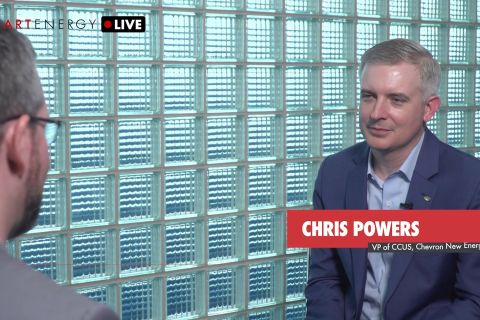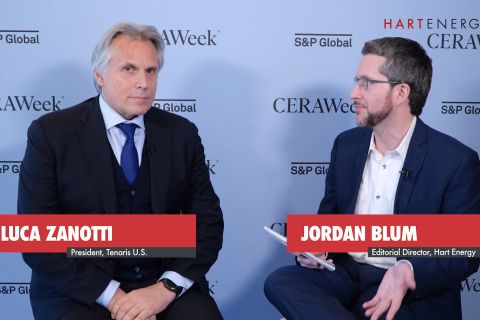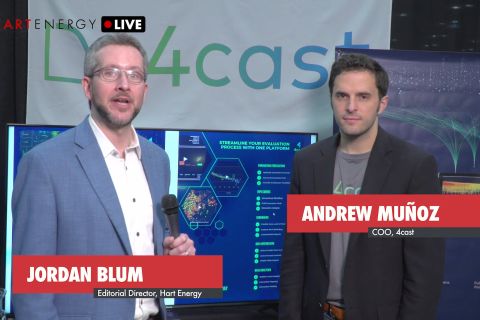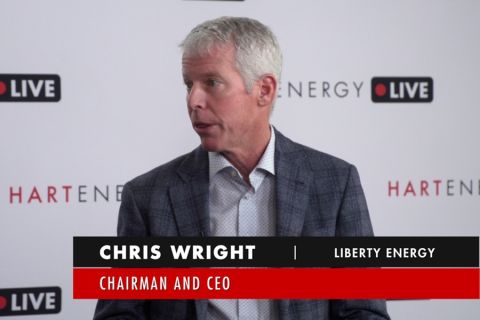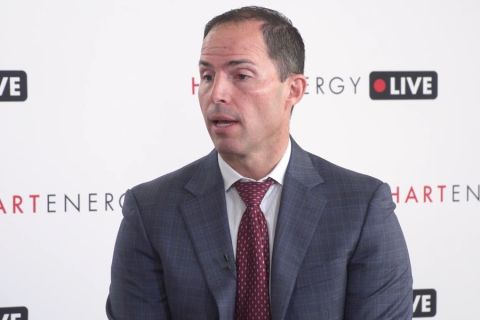Exploration offshore Ireland is about to enter a new chapter with the award of new frontier exploration licenses (FELs) and the entry of some significant new players in the deepwater Porcupine Basin.
Irish independent Petrel Resources was recently granted two new FELs for the Porcupine Basin, 3/14 and 4/14, which cover 1,050 sq km (401 sq miles) out of 1,400 sq km (540 sq miles) originally allocated under previous licensing options (LOs) by Ireland's Department of Communications and Natural Resources in the 2011 Irish Atlantic Margin licensing round.
The new licenses run for 15 years with an initial three-year term followed by three further four-year phases.
Petrel, however, won't be tackling this acreage on its own. It agreed in June 2013 to farm out 85% equity in its LOs to Woodside Energy, through which Petrel is carried for the first three-year exploration term. This term involves reprocessing historic 3-D seismic data, environmental studies and potentially a new 3-D seismic sweep. The options cover LO 11/4, which includes offshore blocks 35/23, 35/24 and 35/25, and LO 11/6, comprising blocks 45/6, 45/11, 45/16 and 44/15.
Woodside’s fresh ideas
A number of geological plays already have been identified on the acreage, justifying additional technical work, according to Petrel’s managing director, David Horgan. “Our operating partner, Woodside, has brought additional ideas based on its technical expertise and past successes elsewhere,” Horgan said. “The next phase of the work program is already underway.”
Last June Woodside also farmed in for a 90% equity in LO 11/3, comprising blocks 35/25(e), 35/30, 36/21, 36/26, 44/5 (part) and 45/1, encompassing a further 1,271 sq km (490 sq miles), with Petrel’s Irish compatriot Bluestack Energy.
Woodside CEO Peter Coleman said at the time that the moves were a commitment to “pursue high-potential exploration opportunities that leverage its deepwater exploration and production capabilities.”
Because the Irish offshore sector is still relatively underexplored, Horgan—a former CEO of explorer Pan Andean Resources—suggests that was one of the reasons that attracted Woodside to the acreage on offer. Another is the attractiveness of the fiscal terms.
“The total number of wells drilled offshore Ireland is 158, of which 28 have been appraisals,” said Horgan. However, those wells have been drilled in acreage covering more than 707,000 sq km (272,900 sq miles).
Porcupine Basin’s 31 wells
“That is not a large amount,” he added. “More than 100 of those wells were in the Celtic Sea [off southern Ireland in shallow water], and they were fairly shallow wells, up to about 3,810 m (12,500 ft). It is an area that is very, very sparsely drilled. But 31 wells have been in the Porcupine Basin, and all of those had oil and gas,” he pointed out. These wells were drilled off Ireland’s southwest coast in water depths of between 200 m and 2,000 m (656 ft and 6,560 ft).
Discoveries include Spanish Point, first found by Phillips Petroleum, 200 km (125 miles) offshore, as well as Connemara and Burren.
Further drilling on Spanish Point is due to kick off using the Blackford Dolphin semisubmersible rig operated by Cairn Energy in Quad 35 later this year after the Irish government approved Cairn's farm-in to FEL 2/04 with Providence Resources.
Mixed views on Irish offshore
However, Horgan admits oil majors still have mixed views of the country’s offshore sector, noting that Phillips and Marathon were both early explorers in the region.
“In about 1985 the majors pulled back out again. They returned in the 1990s, but they have not been back since. More recently, the exploration terms have been dramatically improved: There is a 25% profit tax. You can write off any exploration costs, there is no royalty, no state ‘back-in’ and you have full depreciation [for capital assets],” he explained.
There is a “bonanza tax” for any megadiscoveries, which could increase tax to 40%. But oil prices remain steady, and there is an established Irish gas market and two interconnector gas pipelines to Scotland with a 4% premium to Scottish gas prices.
“This is the first time in 20 years that the Irish authorities have experienced real industry interest in the offshore sector,” Horgan added.
In March this year Ireland's Department of Marine and Natural Resources appointed consultant Wood Mackenzie to advise the government on a new offshore tax regime.
Of Woodside, Horgan says they are “very, very good. They are all about how they operate. They take their time, and they will want to clarify everything.”
He says the Irish energy minister has already committed to converting 12 of the 13 LOs awarded in the 2011 Atlantic Margin round to FELs. Accordingly, Horgan fully expected his company's two LOs to be converted to FELs when he spoke to E&P earlier this year.
However, after major changes in the Irish civil service (which saw a lot of experienced personnel leave), that process took several months longer than expected, although those FELS were eventually converted.
First exploration phase
With those FELs granted and the Woodside farm-in approved, Horgan said there will now be a first exploration phase of three years with existing seismic data to be reprocessed and new data acquired. “Most of the custom data are from the early 1980s. The seismic shows very little chalk, and the definition is very good, and there are some speculative 3-D data. The acquisition is very good, but the interpretation of spec 3-D is bad,” he said.
The company has already reprocessed some data. “But we expect Woodside to reprocess it again,” he said. “There will be [the] purchase of additional data, and we expect further seismic acquisition in due course.”
In the follow-up exploration periods for each license a well is expected to be drilled in each period. Given the water depth of the Petrel/Woodside acreage, ranging from 700 m to 800 m (2,300 ft to 2,624 ft) in LO 11/4 and up to 1,000 m (3,280 ft) in LO 11/6, a high-specification semisubmersible rig or drillship will be required to cope with greater wave frequencies and the likely wave heights in this harsh-environment region.
Petrel reckons its Quad 35 area has a potential 1 Bbbl in place, with stacked targets at Eocene, Lower Tertiary, Lower Cretaceous and Jurassic levels. It also anticipates stacked targets in Quad 45, where it has identified Lower Tertiary and Lower Cretaceous levels of interest after studying previous 2-D and 3-D data and conducting a petrophysical appraisal of 17 previous wells.
Dunquin North boost
The outcome of ExxonMobil’s Dunquin North well—drilled in July 2013 by the Leiv Eiriksson semisubmersible—hasn’t done any harm to the prospects for the area as it encountered 44 m (144 ft) of residual oil shows and 244 m (800 ft) of carbonate.
“It was an enormous plus for us,” Horgan said. “This is the first well that proved that there was not just gas but also oil generation. It enormously eased the task of farming out 11/6. I've heard that the Dunquin well cost about $200 million. I would like to know the age of the rocks, but ExxonMobil have kept it very tight,” he said. “Technically it was a very, very good success.”
However, he believes Woodside may also have its own ideas about the region’s prospects. “It is clear that they have their own particular model to roll out,” he said. “I would be amazed if they did not drill several wells.”
Another Irish Atlantic Margin exploration round also is due to close in September 2015. Full details will be released following the review of the existing fiscal regime later this year.
Recommended Reading
Exclusive: Chevron New Energies' Bayou Bend Strengthens CCUS Growth
2024-02-21 - In this Hart Energy LIVE Exclusive interview, Chris Powers, Chevron New Energies' vice president of CCUS, gives an overview of the company's CCS/CCUS activity and talks about the potential and challenges of it onshore-offshore Bayou Bend project.
Exclusive: Tenaris’ Zanotti: Pipes are a ‘Matter of National Security’
2024-04-12 - COVID-19 showed the world that long supply chains are not reliable, and that if oil is a matter of U.S. national security, then in turn, so is pipe, said Luca Zanotti, U.S. president for steel pipe manufacturer Tenaris at CERAWeek by S&P Global.
Exclusive: As AI Evolves, Energy Evolving With It
2024-02-22 - In this Hart Energy LIVE Exclusive interview, Hart Energy's Jordan Blum asks 4cast's COO Andrew Muñoz about how AI is changing the energy industry—especially in the oilfield.
Exclusive: Liberty CEO Says World Needs to Get 'Energy Sober'
2024-04-02 - More money for the energy transition isn’t meaningfully moving how energy is being produced and fossile fuels will continue to dominate, Liberty Energy Chairman and CEO Christ Wright said.
Chesapeake, Awaiting FTC's OK, Plots Southwestern Integration
2024-04-01 - While the Federal Trade Commission reviews Chesapeake Energy's $7.4 billion deal for Southwestern Energy, the two companies are already aligning organizational design, work practices and processes and data infrastructure while waiting for federal approvals, COO Josh Viets told Hart Energy.

